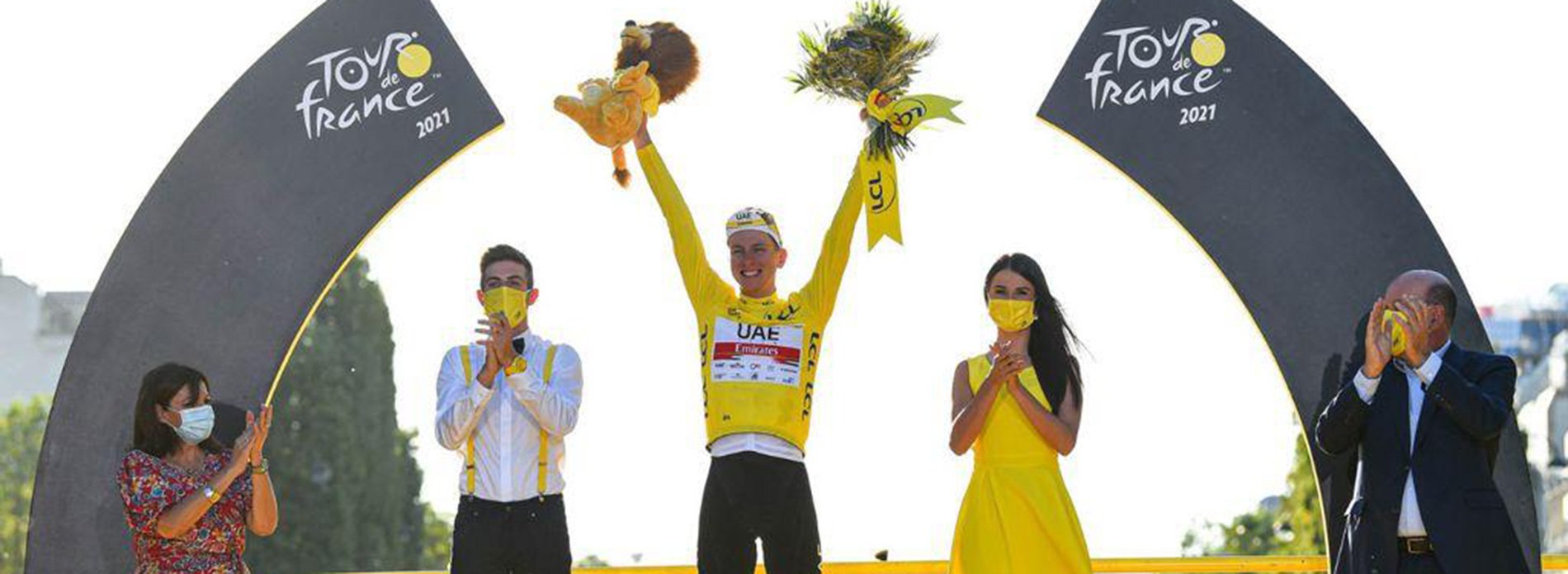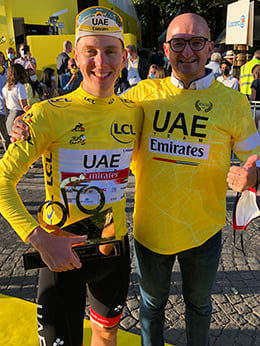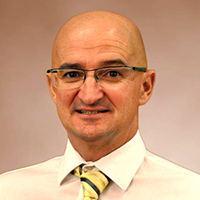First of all, congratulations on an incredible accomplishment – your top cyclist winning his second Tour de France.
It was a great victory. This year we were not the underdog anymore. It’s too bad (Primoz) Roglic (last year’s second-place General Classification finisher) had a bad crash and had to quit the race. It was unfortunate because otherwise it would have been better (duel-wise between the two top-rated Slovenians). He crashed in the first week.
Did you change the UAE strategy this year, given that the team, with Tadej at the lead, was no longer the underdog?
We did all the homework for the Tour de France in Sestriere, which is in the Italian Alps. I told the team the first day of pre-training camp, ‘Guys, let’s take this seriously. Let’s focus, because we have never been in this situation. We have never had to defend a Tour de France, and since the very last day of last year’s Tour, everybody has tried to figure out how to beat Tadej. Everybody’s guns are loaded to shoot at us this year. Be ready for that.’
Our strategy was to try to control the race as best as we could, and that was the most stressful part – to put together that block of riders. Out of 29 riders we have on the team, to select that block of seven who could help Tadej do the job. Ineos Grenadiers would be the team to bring the race. … They have a very strong roster, and they are signing from other teams their leaders, so it’s difficult to compete as a block against Ineos. But we were able to put a good block together, and yeah, it worked out.
Stage 20, the second-to-last stage of the Tour de France, went from Libourne to Saint Emilion, which translates to San Millán in French. Just a coincidence?
Yeah, it was a coincidence (laughs). It was the last time trial, and that was when we kind of said, ‘OK, boom, now we won the Tour,’ and we celebrated. Also, that is an area of the world with some of the best wines – some are $3,000 a bottle. … I’m crazy about wine, so that area was very special because of Tadej, because of the wine and because of my last name (laughs).
What makes Tadej such a good stage racer?

He has an amazing recovery capacity. Each stage of the Tour is like (playing) about three soccer games, or five American football games. So, imagine playing five games for 21 days in a row. By day 10, many players would be gone, right? Only the best, the fittest ones, will make it to day seven, 10 and so on. This is how fit these cyclists are. Their (physiologic) machinery is some of the best you will ever find in humans. These athletes and marathon runners, but probably more so cyclists, because they have to recover between stages.
And while everybody might start (a stage) at 100%, some people finish at 60% because they go lower and lower and lower. And maybe Tadej finishes at 80%, so that 20% extra at the end is what makes one of his parameters. Contenders at the Tour all recover well. But at the same time, you also have other physiological capabilities which are the ability to clear lactate, to have very good mitochondrial function. You need to have a very economical and efficient engine, but it’s both the recovery capacity and the ability to go at a very hard pace without utilizing a lot of energy.
Last year, you measured metabolites in his blood over the course of the race. Did you do that again this year?
No, we didn’t do that this year at the Tour because the logistics have been difficult. … We (Angelo D’Alessandro, PhD, Travis Nemkov, PhD, and San Millán) are developing the first metabolomics platform in the world of sports. … We’re very close to the finish line. … We learned a lot from last year, but from this year also. We did a training camp and at another race, so we looked at more parameters, and all of it keeps telling us the same story: Tadej’s recovery capacity and mitochondrial function are spectacular, at a whole different level. He has an ability to burn fat and use fuels very efficiently.
What do you mean by ‘platform’?
It’s like the 23andMe or the DNA test kits you can buy in the supermarket and do yourself and send through the mail to a laboratory. In a few days you get the whole report. This (platform) would be for metabolomics, which is more precise than genetics. Genetics is the science of probability, and metabolomics is the science of reality.
‘Genetics is the science of probability, and metabolomics is the science of reality.’ – Inigo San Millan
In genetic testing, especially for sports, the accuracy might be less than 20%. A few years ago, athletes would get these genetic tests and they showed, ‘Oh, you’re not a good sprinter’ or ‘You’re not a good climber’ or ‘You don’t have much strength or power.’ That’s only because a few genes showed that, but you can improve the signal, the expression, of those genes through training, through nutrition, through recovery, through the right psychology. This is where you can transform a normal athlete into a very good athlete. And this is what we capture through metabolomics.
Genes are transcribed into proteins, and proteins into multiple biological actions. So, the genes are the very first step of the journey, but by no means do they mean an athlete is going to become something. That’s why the accuracy is less than 20%, whereas in metabolomics it’s, ‘Hey, this is who you are right now, and now we know how you can improve.’
This is what we’re developing. It’s a platform where someone can send a blood sample put on a small card before and after exercise, and we can then give them those metabolomic parameters.
So you have one of the best athletes in the world as part of your dataset for the development of this platform?
Yes, exactly, so we know the upper levels of human physiology and metabolic health.
In the opening stage of the Tour, a spectator caused a massive crash by holding out a sign on the edge of the road. Was Tadej affected by this incident?
It was really bad. And 10 or 15 kilometers later, there was another bad crash, and I forget in which of them Tadej received a minor cut. It didn’t affect him much.
You have mentioned that Tadej has a unique metabolic signature. Can you explain why that signature is significant?
We have patterns or signatures – at the research level we call them signatures – and this is what we see as ‘who you are now.’ With this, we can help athletes to improve. At the same time – and this is our ultimate goal – we want to take this into the fitness, wellness and even the clinical space. Because with the lessons we have learned from these athletes, we can understand the many pathologies people are having at the metabolic level, as athletes are the absolute gold standard of metabolic health.
For example, people with Type 2 diabetes are at the opposite metabolic pole of someone like Pogačar. They don’t burn fat very well at all, they don’t burn glucose. They have very poor mitochondrial function, and they have inflammation, whereas Pogačar is completely the opposite. This is something I’ve been pushing at the university for years, since I arrived, using elite athletes as the gold standard.
I think some people are finally understanding this concept – that, yes, you cannot understand imperfection if you don’t first understand perfection. In my modest opinion, the best way to understand a faulty metabolism, like people with Type 2 diabetes, is to in the first place understand how does a perfect metabolism work? And who do you go to to understand that? You don’t go to the sedentary people who, until recently, have been the gold standard. … That’s not the best population to go to (for study). You need to go to the elite athletes.
To our advantage … we have access to these populations which most scientists don’t have access to. So, we are very lucky to have this unique population to be able to understand what perfection is. And now we know better how to get there and how bad imperfection is. So, we can use all of these technologies for diagnoses and also therapeutics down the road for people with chronic diseases.
Last year you mentioned that Tadej has amazing mental focus to go with his physical strength. Do you feel that’s a big part of his success?
Absolutely. For someone his age, he’s amazing. It seems like you’re dealing with a 30-plus-year-old professional athlete who has been a professional for 10 or 15 years. It’s unbelievable. And also, how calm he is. He doesn’t feel so much the stress of the competition as others. … Some great athletes have amazing physiological capabilities, but they can’t sleep well the day before an event, or they have anxiety and are nervous the day of the competition, and they can’t give their 100%. It’s not uncommon at all and it’s too bad, because some of them could have been incredible athletes. But I guess that’s what it takes to be a big, big champion – to have all these qualities together.
So far, nobody in (cycling) history has done what Tadej has done at this age. The best rider ever is Eddy Merckx … and Tadej has done more than what Merckx had done at his age. So this is the unusual and special thing about Tadej.
So, what’s next for Tadej, and are you already preparing to win a third Tour de France next year?
From the Tour he went to Tokyo for the Summer Olympics where took the bronze medal in the road race, and he was the one who broke the entire race. Also, we have an American from the UAE team at the Olympics, too, Brandon McNulty, who I also personally coach. He was in the Tour with Tadej. … Brandon can be one of the best time trialists in the world. He placed sixth in the road race in Tokyo and was the best finish of an American cyclist since 2012.
Regarding Tadej, absolutely, a third Tour win in a row is the goal. You always want to win and keep breaking records. We are already thinking about next year, how we can keep improving. … We still have some margin for improvement, but the other (teams) do, too. As we’re speaking, they’re trying to figure out how to do things better for next year. … This is why next year it will be harder than this year for sure. We better be prepared and not sleep on our laurels.

.png)





